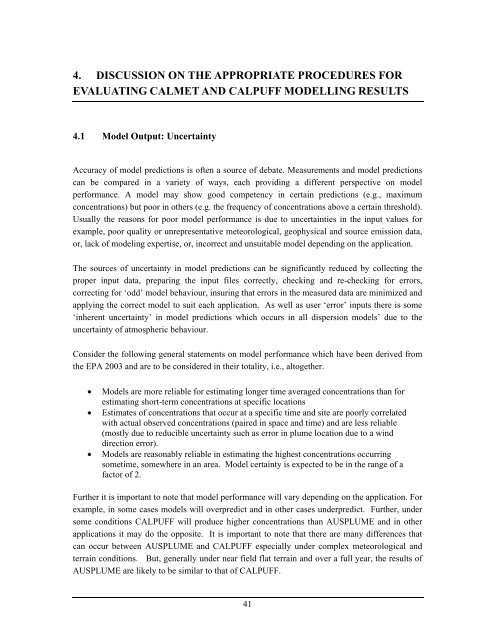Generic Guidance and Optimum Model Settings for the CALPUFF ...
Generic Guidance and Optimum Model Settings for the CALPUFF ...
Generic Guidance and Optimum Model Settings for the CALPUFF ...
You also want an ePaper? Increase the reach of your titles
YUMPU automatically turns print PDFs into web optimized ePapers that Google loves.
4. DISCUSSION ON THE APPROPRIATE PROCEDURES FOR<br />
EVALUATING CALMET AND <strong>CALPUFF</strong> MODELLING RESULTS<br />
4.1 <strong>Model</strong> Output: Uncertainty<br />
Accuracy of model predictions is often a source of debate. Measurements <strong>and</strong> model predictions<br />
can be compared in a variety of ways, each providing a different perspective on model<br />
per<strong>for</strong>mance. A model may show good competency in certain predictions (e.g., maximum<br />
concentrations) but poor in o<strong>the</strong>rs (e.g. <strong>the</strong> frequency of concentrations above a certain threshold).<br />
Usually <strong>the</strong> reasons <strong>for</strong> poor model per<strong>for</strong>mance is due to uncertainties in <strong>the</strong> input values <strong>for</strong><br />
example, poor quality or unrepresentative meteorological, geophysical <strong>and</strong> source emission data,<br />
or, lack of modeling expertise, or, incorrect <strong>and</strong> unsuitable model depending on <strong>the</strong> application.<br />
The sources of uncertainty in model predictions can be significantly reduced by collecting <strong>the</strong><br />
proper input data, preparing <strong>the</strong> input files correctly, checking <strong>and</strong> re-checking <strong>for</strong> errors,<br />
correcting <strong>for</strong> ‘odd’ model behaviour, insuring that errors in <strong>the</strong> measured data are minimized <strong>and</strong><br />
applying <strong>the</strong> correct model to suit each application. As well as user ‘error’ inputs <strong>the</strong>re is some<br />
‘inherent uncertainty’ in model predictions which occurs in all dispersion models’ due to <strong>the</strong><br />
uncertainty of atmospheric behaviour.<br />
Consider <strong>the</strong> following general statements on model per<strong>for</strong>mance which have been derived from<br />
<strong>the</strong> EPA 2003 <strong>and</strong> are to be considered in <strong>the</strong>ir totality, i.e., altoge<strong>the</strong>r.<br />
� <strong>Model</strong>s are more reliable <strong>for</strong> estimating longer time averaged concentrations than <strong>for</strong><br />
estimating short-term concentrations at specific locations<br />
� Estimates of concentrations that occur at a specific time <strong>and</strong> site are poorly correlated<br />
with actual observed concentrations (paired in space <strong>and</strong> time) <strong>and</strong> are less reliable<br />
(mostly due to reducible uncertainty such as error in plume location due to a wind<br />
direction error).<br />
� <strong>Model</strong>s are reasonably reliable in estimating <strong>the</strong> highest concentrations occurring<br />
sometime, somewhere in an area. <strong>Model</strong> certainty is expected to be in <strong>the</strong> range of a<br />
factor of 2.<br />
Fur<strong>the</strong>r it is important to note that model per<strong>for</strong>mance will vary depending on <strong>the</strong> application. For<br />
example, in some cases models will overpredict <strong>and</strong> in o<strong>the</strong>r cases underpredict. Fur<strong>the</strong>r, under<br />
some conditions <strong>CALPUFF</strong> will produce higher concentrations than AUSPLUME <strong>and</strong> in o<strong>the</strong>r<br />
applications it may do <strong>the</strong> opposite. It is important to note that <strong>the</strong>re are many differences that<br />
can occur between AUSPLUME <strong>and</strong> <strong>CALPUFF</strong> especially under complex meteorological <strong>and</strong><br />
terrain conditions. But, generally under near field flat terrain <strong>and</strong> over a full year, <strong>the</strong> results of<br />
AUSPLUME are likely to be similar to that of <strong>CALPUFF</strong>.<br />
41

















